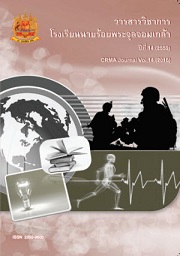การพัฒนาพิพิธภัณฑ์เสมือนจริงสามมิติเครื่องดินเผาชิ้นเอกบ้านเชียง
Main Article Content
บทคัดย่อ
งานวิจัยครั้งนี้มีวัตถุประสงค์เพื่อ1) รวบรวมข้อมูลและจัดทำภาพสามมิติของเครื่องดินเผาชิ้นเอกบ้านเชียง 2) จัดระบบข้อมูลวัตถุเครื่องดินเผาชิ้นเอกบ้านเชียง และ 3) ออกแบบและพัฒนาพิพิธภัณฑ์เสมือนจริงสามมิติเครื่องดินเผาชิ้นเอกบ้านเชียง ดำเนินการวิจัยโดยวิธีวิจัยและพัฒนา ซึ่งมี 3 ระยะคือ ระยะที่ 1 ใช้วิธีการวิเคราะห์เอกสาร เพื่อให้ได้ข้อมูลของเครื่องดินเผาแต่ละชิ้น และการถ่ายภาพดินเผาตามวิธีการถ่ายภาพ 3 มิติ ระยะที่ 2 ใช้วิธีการวิเคราะห์และสังเคราะห์ระบบจัดเก็บข้อมูลเครื่องดินเผา จากมาตรฐานเดิมที่มีอยู่ ร่วมกับการลงพื้นที่เพื่อสัมภาษณ์ผู้เชี่ยวชาญเพื่อให้ได้ข้อมูลเชิงลึกในมิติทางศิลปะ และสังคมวัฒนธรรม ที่จะนำมาใช้อธิบายเนื้อหาและปรากฏการณ์ในพิพิธภัณฑ์เสมือนจริงที่จะสร้างขึ้น และระยะที่ 3 การพัฒนาพิพิธภัณฑ์เสมืองจริง ตามแนวคิดแบบจำลองการออกแบบและพัฒนาระบบมัลติมีเดียปฏิสัมพันธ์ (Model of Interactive Multimedia System Design and Development: IMSDD) ผลการศึกษาทำให้ได้ (1) เมทาดาทาสำหรับการบันทึกข้อมูลเครื่องดินเผาที่มี 20 เขตข้อมูล รวมทั้งเนื้อหาของเครื่องดินเผาแต่ละชิ้นที่สามารถนำมาเล่าเรื่องในพิพิธภัณฑ์เสมือนได้ตามยุคสมัย และตามมิติทางศิลปะ และสังคมวัฒนธรรม (2) พิพิธภัณฑ์เสมือนจริงสามมิติเครื่องดินเผาชิ้นเอกบ้านเชียง ที่มีสถาปัตยกรรมระบบประกอบด้วย 3 ส่วนคือ (2.1) วัตถุ 3 มิติ (2.2) กระบวนการจัดการ ได้แก่ การจัดการส่วนนิทรรศการ และการจัดการเนื้อหาของวัตถุที่นำมาแสดง และ (2.3) การจัดแสดง ได้แก่ ส่วนประสานกับผู้ใช้ให้อยู่ในรูปแบบที่เป็นสื่อเสมือนจริง 3 มิติ พิพิธภัณฑ์เสมือนจริงสามมิติเครื่องดินเผาชิ้นเอกบ้านเชียงนี้ จะสามารถนำไปใช้เป็นแหล่งเรียนรู้เกี่ยวกับบ้านเชียงผ่านเว็บได้ และใช้เป็นต้นแบบในต่อยอดการพัฒนาพิพิธภัณฑ์เสมือนจริง 3 มิติของวัตถุอื่นๆได้
Article Details
ผลงานที่ได้รับการตีพิมพ์ ถือเป็นลิขสิทธิ์ของวารสารฯ
เอกสารอ้างอิง
กองพิพิธภัณฑสถานแห่งชาติ. (2536). คู่มือ: การปฏิบัติงานของภัณฑารักษ์พิพิธภัณฑสถานแห่งชาติ กรมศิลปากร. กรุงเทพฯ: กรมศิลปากร.
ยืน ภู่วรวรรณ.(2545).พจนานุกรมคอมพิวเตอร์และอินเตอร์เน็ต.กรุงเทพฯ: ซีเอ็ดยูเคชั่น.
พิพิธภัณฑสถานแห่งชาติบ้างเชียง.(2550). มรดกวัฒนธรรมบ้างเชียง = Ban Chiang Heritage. กรุงเทพฯ: กรมศิลปากร.
สำนักโบราณคดีและพิพิธภัณฑ์สถานแห่งชาติ กรมศิลปากร.(2544).การใช้ประโยชน์พิพิธภัณฑสถานแห่งชาติและอุทยานประวัติศาสตร์ให้เป็นแหล่งเรียนรู้ตลอดชีวิต. รายงานการประชุมเชิงปฏิบัติการการปฏิรูปการศึกษาและการบริหารจัดการทรัพย์สินทางศิลปะวัฒนธรรม. กรุงเทพฯ: สุวรรณภูมิ.
Dastbaz, M. (2002). Designing Interactive Multimedia Systems. McGraw-Hill, London.
Mclellan, H. (1998). Cognative Issue in Virtual Reality. Journal of Visual Literacy 18 (October):175-199.
Stephen,B.D. (1996).The Design of Virtual Enviroments With particular reference to VRML (online).Retrieved October1, 2015, from http://www.man.ac.uk.
Styliani, S., Fotis, L., Kostas, K., & Petros, P.(2009). Virtual museums, a survey and some issues for consideration. Journal of Cultural Heritage, 10(4), 520–528.
The Network Development and MARC Standards Office of the Library of Congress. (2015). VRA Core 4.0 Schemas and Documentation. Retrieved February 12, 2015 from http://www.loc.gov/standards/vracore/ schemas.html.
UNESCO.(1963).The International Council of Museums (ICOM) Seminar on“The Education Role of Museum”. Available on: http://icom.museum/the-governance/general-assembly/resolutions-adopted by-icoms-general-assemblies-1946-to-date/amsterdam-1962/ access 29 august 2015.


